Planting petunias for seedlings: care features, general information about the plant
Petunia is a beautiful bright flower with a pleasant smell that can be found in any city and suburb of our country. Gardeners simply adore petunias for their beauty and unpretentiousness. This spectacular flower is ideal for windowsills and balconies, as well as for open spacious flower beds. Planting petunias for seedlings is quite simple, they begin to bloom quickly.
Content:
- General information about petunias
- Planting petunias for seedlings
- Petunia care
- Types and varieties of petunias
General information about petunias
Petunias are both annual and perennial. It is a plant in the Solanaceae family, making it a distant relative of tomato, potato and tobacco. The word "petun" is translated from Portuguese as "tobacco". Petunias can grow up to 1 m in height, depending on the variety
The homeland of petunias is hot South America, which makes this plant so thermophilic.
This flower was discovered and described in his works by the famous botanist Jean-Baptiste Lamarck. Most of the varieties were found in Brazil, where they grew along river banks. Some species were discovered quite recently, at the end of the 20th century.
Description of petunia:
- Petunia flowers are usually single, bright, with five petals, and can be of various colors: white, red, pink, purple, yellow, blue.
- The seeds are small.
- On closer inspection, you may notice that the stems and leaves of the petunia are covered with hairs.
Petunia blooms for a very long time... If you plant it in time, it will delight you with its bright flowers in early June and will not stop blooming until the first cold weather. There are many legends about this flower. According to one of them, a beautiful princess was imprisoned in a dark castle by a dragon. She was supposed to entertain him, sing and dance, but she herself was very sad in the castle. She loved to paint, but she had no paints or canvas.
One day she went out onto the balcony and sang. Birds flocked to her singing. The princess was overjoyed and asked them to bring her various herbs, flowers and roots so that she could make dyes out of them. When the paints were ready, the canvas had to be found. The princess decided to paint on the walls that surrounded her. Gloomy stones quickly began to turn into incredible beauty paintings. When there was no empty space left, the walls collapsed, and the princess freed herself, and a carpet of beautiful bright flowers - petunias - remained in place of the ruins.
Planting petunias for seedlings
To grow seedlings, you need to stock up on additional light sources. Then it will be possible to plant seeds at the end of winter. However, the best time for planting is the second half of March.
There are several requirements for planting petunia seeds, by fulfilling which, you will ensure yourself a beautiful lush seedling:
- In early spring, daylight hours are still short, so not all seeds will sprout. For this reason, you need to pour more seeds.
- The soil for planting must be light, enriched with humus, peat, well loosened and moisturized. Moisten the soil the day before planting.
- The seeds are placed on the ground, after mixing them with a small amount of dry sand. Then they are carefully leveled, but not tamped.
- When the seeds have already been planted, the soil should be moistened with a sprayer and covered with foil or glass. At the same time, the temperature should not be too high, a little more than 20 degrees.
- Until the first leaves appear on the seedlings, do not remove the glass.
- The humidity should be high enough, however, excessive dampness should not be allowed so that the plant does not rot. Therefore, if you see condensation droplets on glass or film, turn it over and wipe it thoroughly.
- First shoots you need to carefully spray, periodically replacing the water with a weak solution of potassium permanganate.
- After you see the first leaves on the seedlings, feel free to remove the glass. Now you need to sprinkle them with a little sand and reduce watering.
When there are already several leaves, you can engage in planting seedlings. It's easy to do. The soil must be pre-moistened to make it easier to pull out the plant. It is necessary to pull the sprout carefully, by the leaf, without shaking off the soil from the root system. Then just plant the plant in a separate pot with the same mixture as you did when planting the seeds.
The transplanted petunia also needs to be covered with foil for several days.
Watering should be regular, providing moderate moisture. After a week, you can start feeding the plant with various fertilizers. You can buy them in specialized stores. Top dressing should take place once a week.
Petunia care
Petunia care is simple and does not require any special skill from you. However, some rules still need to be followed in order for the flower bed to please the eye. As mentioned above, petunia loves warmth very much. Therefore, it is important to maintain the correct temperature regime, especially when growing seedlings. But this does not mean that the pot of seedlings should be placed near a scorching battery. The soil should not dry out. A dry crust on the ground can negatively affect the seedlings, they will simply suffocate.
It is necessary to plant petunia in open ground only after all the frosts have passed and there is no threat of their return.
The scorching sun is also not suitable for disembarkation. If cloudy days are not expected, choose an afternoon for this procedure, when the sun is no longer so bright.
Despite the love of heat, petunias do not tolerate severe drought. For the same reason, plants need water regularly... This is done very carefully so as not to damage the fragile flowers. The larger the variety of the flower, the more demanding it is in terms of keeping conditions.
Flower feeding:
- The fertilizers with which you feed the petunia should have enough potassium. This is essential for proper growth and flowering of the plant.
- Moreover, you need to feed it weekly until the very end of summer.
- Fresh manure should not be added to the soil, as it can cause fungus.
- Various organic fertilizers such as humil are very good.
The area where you are planting petunias should be open to the sun. Therefore, make sure that there are no tall trees, fences nearby and the flower bed will be lit for most of the day.
If you want your petunia to bloom until November, plant it already in bloom.
Cut off the withered flowers. This will make the plant stronger and the flower bed more beautiful. If you notice that the stems and leaves have begun to darken, treat the petunia with a special anti-rot solution. It can be purchased at a gardening store.
Aphids are especially dangerous for petunias, since in this case the plant dies quickly enough. The seeds can be harvested after two months from the beginning of flowering. Choose large, healthy flowers that bloom earlier than others.
Types and varieties of petunias
Petunia has many species, subspecies and groups. Let's consider the most basic varieties:
- Bush petunia. Bush petunia has the largest number of species. These are quite large, bright flowers that require special care. However, despite the beauty of the flower, it has its drawbacks. These include a small number of buds, their fragility.Rain and wind can easily damage such a flower bed.
- Creeping petunia. This petunia differs in that there are a large number of buds on its long flexible stems, for this reason the stem does not stretch up, but spreads. Such flowers are good for balconies and flower beds, where there is enough horizontal space. The most flexible stem belongs to the variety called Surfinia. It also has many types, but all of them are united by resistance to adverse environmental conditions.
- Multi-flowered petunia. From the name it is clear that such a petunia has many small flowers. They do not look as impressive as large ones, but they are more tenacious in conditions of strong wind and rain. This petunia blooms for a long time and is unpretentious to care for. Small, densely planted flowers will resemble a colorful bright carpet.
- Dwarf petunia. Dwarf petunia is small in stature, below 30 cm. This compact flower is perfect for small flower beds. He loves light and moisture, however, with excessive moisture, he quickly decays. Caring for him should be especially careful.
- Terry petunia. This beautiful lush flower is hard to miss. To make the flower bed look beautiful, flowers need to be planted not too close to each other. One of the newer terry petunias is the Angora, a lush flower with small leaves. It is unpretentious, blooms for a long time and is able to survive even a strong wind. The disease-resistant Sonata variety has light pink flowers and dense foliage.
- Cascading petunia. This type of petunia is perfect for hanging planters and boxes. The Double Cascade variety with beautiful two-color buds and a delicate aroma has earned a special love of gardeners.
Whichever variety you prefer, petunia will become a great decoration for the garden, and will appeal to all flower lovers. Not too laborious care and a variety of varieties will allow you to create the most interesting and beautiful compositions.
More information can be found in the video.



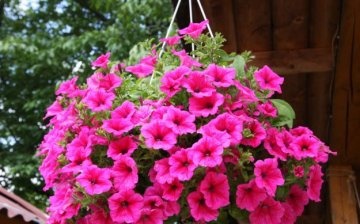
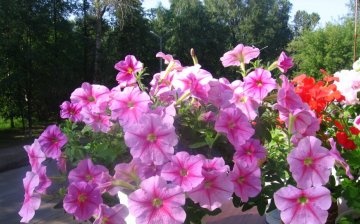
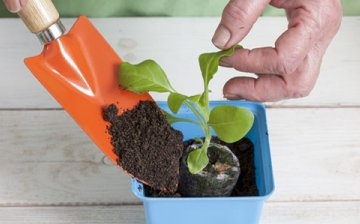
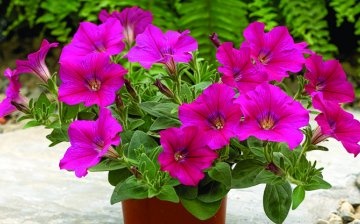
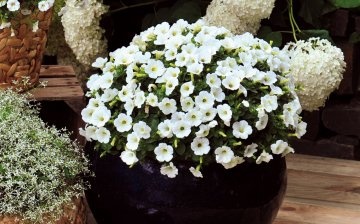





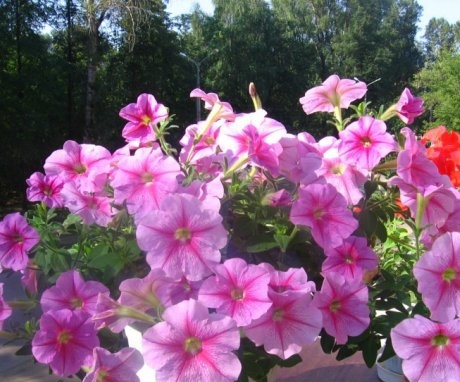

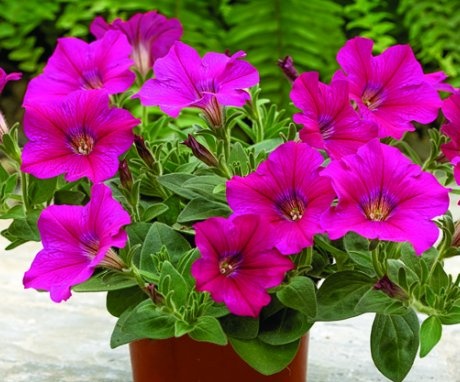
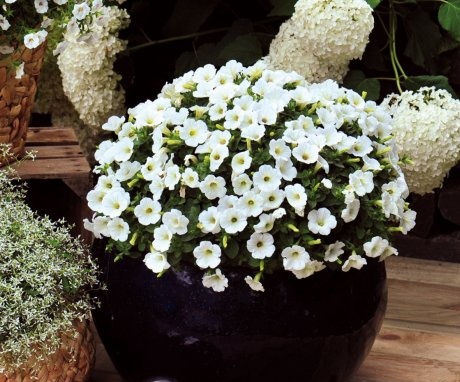
I love creeping and multi-flowered petunia very much. I plant it on seedlings, and after germination I transplant and form flower beds and lawns. The flower is not whimsical, it can grow under the scorching sun. The main thing is to water it moderately and not to water it. Otherwise it will be lost.